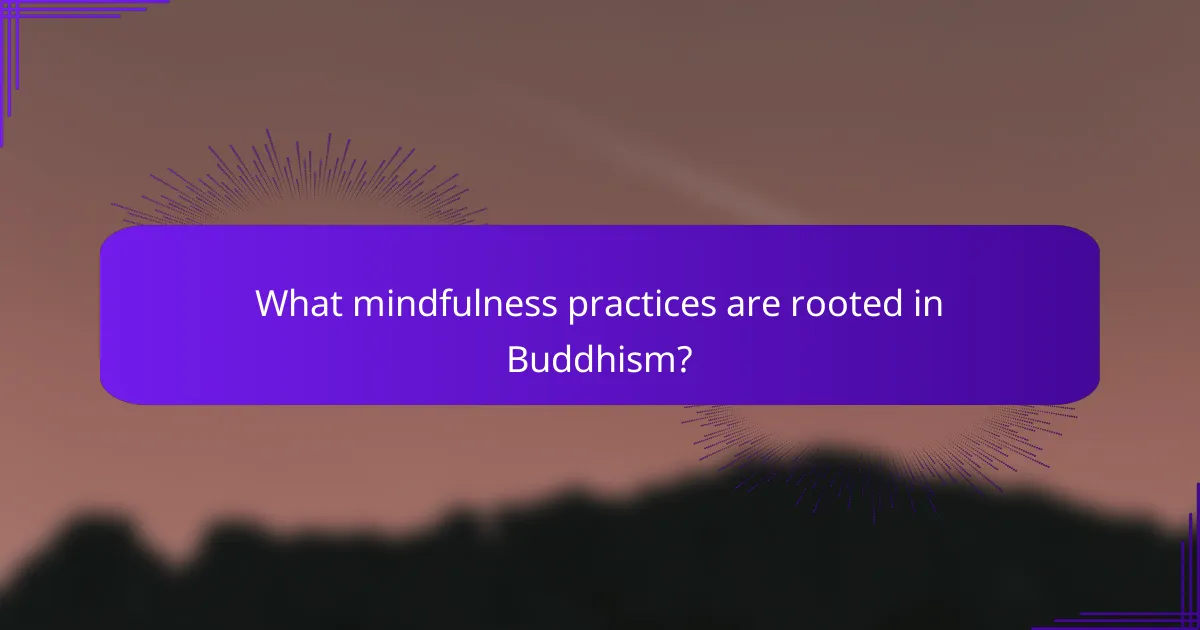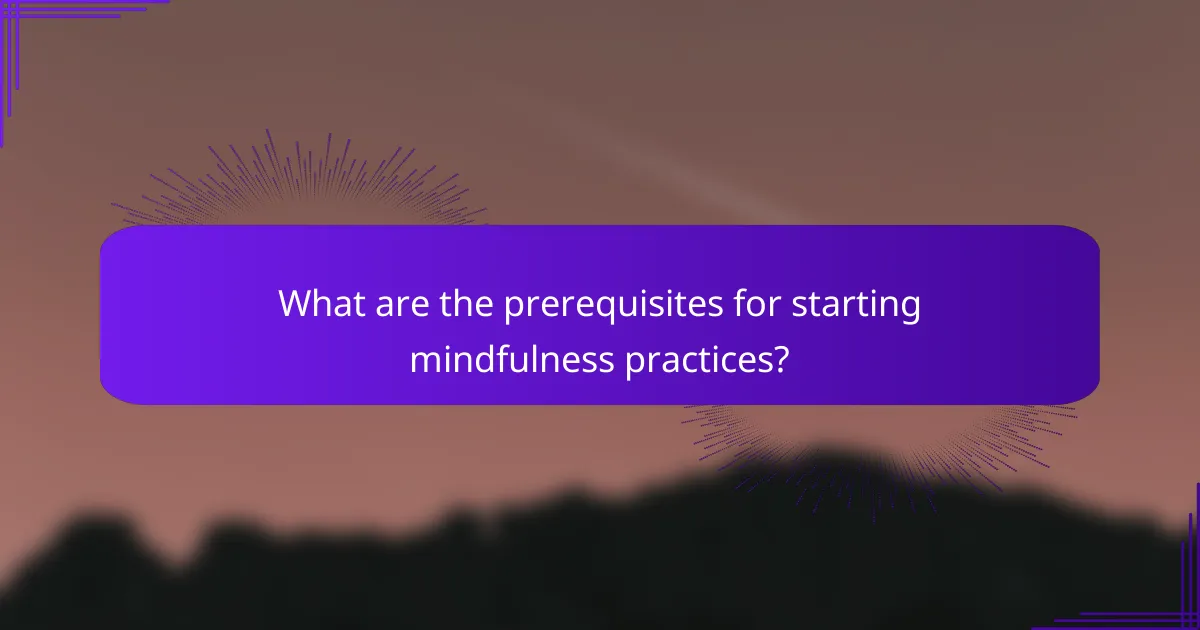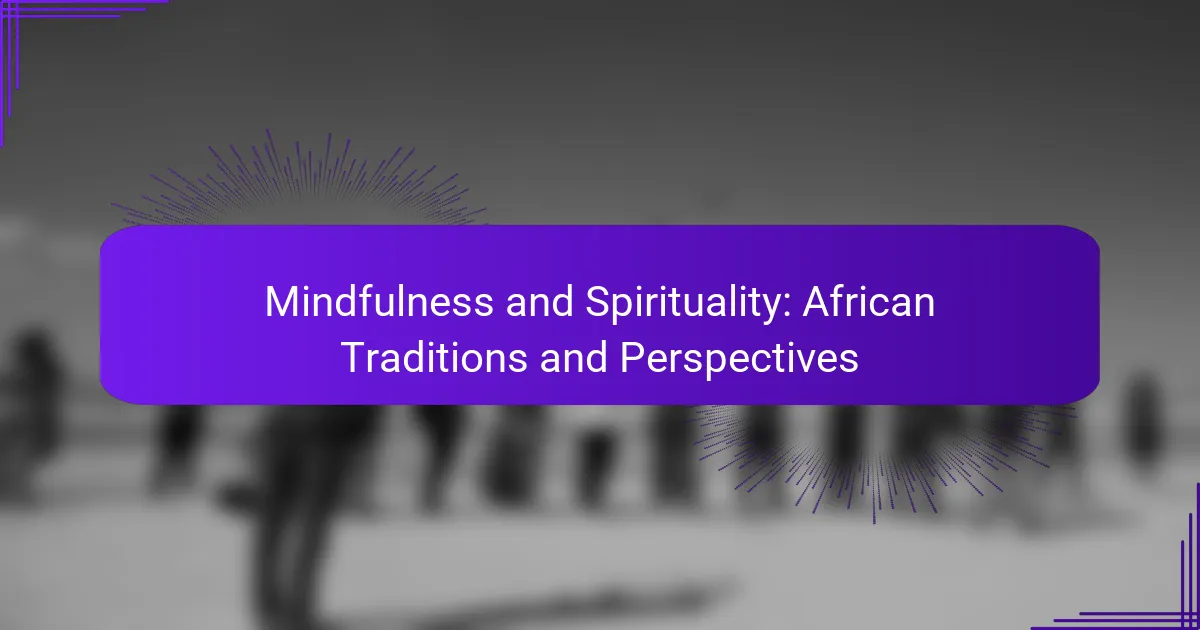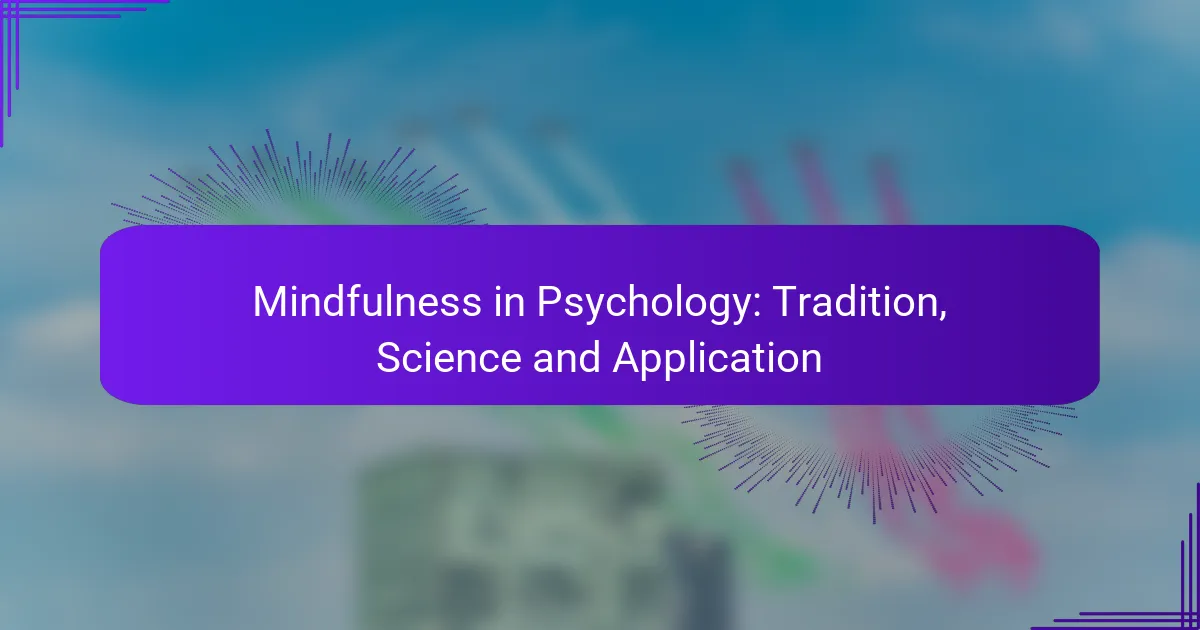Mindfulness practices across Buddhism, Hinduism, and Taoism offer unique pathways to enhance awareness and presence. Buddhism emphasizes mental clarity and emotional regulation, while Hinduism incorporates techniques like yoga and pranayama to foster inner connection. Taoism promotes harmony with nature through practices such as Qigong and Tai Chi, encouraging a relaxed and mindful approach to life.

What mindfulness practices are rooted in Buddhism?
Mindfulness practices rooted in Buddhism focus on cultivating awareness and presence in the moment. These techniques aim to enhance mental clarity, emotional regulation, and a deeper understanding of oneself and the world.
Zen meditation
Zen meditation, or Zazen, emphasizes sitting in silence and observing thoughts without attachment. Practitioners typically sit on a cushion with a straight posture, focusing on their breath or simply being present in the moment.
To practice Zen meditation, find a quiet space, sit comfortably, and set a timer for 10 to 30 minutes. Begin by taking a few deep breaths, then allow your thoughts to come and go without judgment. This practice can help improve concentration and reduce stress.
Mindful breathing
Mindful breathing involves paying close attention to the breath as it flows in and out. This practice can be done anywhere and is particularly effective for grounding oneself during stressful situations.
To practice mindful breathing, take a moment to focus on your inhalations and exhalations. Aim for a slow, steady rhythm, and notice the sensations of the breath entering and leaving your body. Even a few minutes of this practice can help calm the mind and enhance focus.
Vipassana meditation
Vipassana meditation, or insight meditation, aims to develop a deep awareness of the body and mind. This practice often involves observing bodily sensations, thoughts, and emotions without attachment or aversion.
Vipassana retreats typically last from a few days to several weeks, where participants engage in silent meditation for many hours each day. For beginners, starting with short sessions of 10 to 20 minutes can be beneficial to gradually build the skill of observation.
Metta (loving-kindness) meditation
Metta meditation focuses on cultivating feelings of love and compassion towards oneself and others. This practice involves silently repeating phrases that express goodwill and kindness.
To practice Metta meditation, find a comfortable position and begin by directing kind wishes towards yourself, such as “May I be happy, may I be healthy.” Gradually extend these wishes to loved ones, acquaintances, and even those with whom you have difficulties. This practice can foster emotional resilience and improve relationships.

How can Hinduism enhance mindfulness?
Hinduism enhances mindfulness through various practices that cultivate awareness and presence. Techniques such as yoga, pranayama, and bhakti encourage individuals to connect with their inner selves and the world around them, fostering a deeper sense of peace and clarity.
Yoga as a mindfulness practice
Yoga is a holistic practice that combines physical postures, breathing exercises, and meditation to promote mindfulness. By focusing on the body and breath, practitioners become more aware of their thoughts and feelings, allowing them to cultivate a state of presence.
To effectively use yoga for mindfulness, consider incorporating a daily routine that includes poses like Sukhasana (Easy Pose) or Savasana (Corpse Pose). Aim for sessions lasting 20-60 minutes, depending on your schedule and experience level.
Pranayama (breath control)
Pranayama involves breath control techniques that enhance mindfulness by regulating the breath and calming the mind. Techniques such as Nadi Shodhana (alternate nostril breathing) or Ujjayi (victorious breath) can help reduce stress and increase focus.
Start with simple practices, dedicating 5-10 minutes daily to pranayama. Pay attention to the sensations of your breath, allowing yourself to become fully present in the moment.
Bhakti (devotional practices)
Bhakti emphasizes devotion and love for a personal deity, which can deepen mindfulness through rituals and prayers. Engaging in bhakti practices, such as chanting or singing hymns, fosters a sense of connection and presence.
To incorporate bhakti into your mindfulness routine, set aside time each day for devotional activities. This could include chanting mantras for 10-15 minutes or participating in community worship, which can enhance your sense of belonging and awareness.

What Taoist techniques promote mindfulness?
Taoist techniques that promote mindfulness include practices like Qigong, Tai Chi, and the principle of Wu Wei. These methods emphasize harmony with nature, body awareness, and a relaxed approach to action, fostering a mindful state of being.
Qigong
Qigong is a holistic practice that combines movement, meditation, and controlled breathing to cultivate and balance vital energy, or “Qi.” Practitioners often perform gentle, flowing movements that enhance physical health and mental clarity. Regular sessions, even as short as 10-20 minutes, can significantly improve mindfulness and reduce stress.
To practice Qigong, find a quiet space, stand with your feet shoulder-width apart, and focus on your breath. Begin with simple movements like raising your arms while inhaling and lowering them while exhaling. This rhythmic motion helps center your mind and body.
Tai Chi
Tai Chi is a martial art known for its slow, graceful movements that promote relaxation and mindfulness. It emphasizes fluid transitions between postures, allowing practitioners to cultivate awareness of their body and surroundings. Engaging in Tai Chi for 20-30 minutes several times a week can enhance mental focus and emotional balance.
To start Tai Chi, join a local class or follow online tutorials. Focus on maintaining a relaxed posture and smooth movements, allowing your mind to stay present in the moment. Avoid rushing through the forms; instead, embrace the meditative quality of each motion.
Wu Wei (effortless action)
Wu Wei, or “effortless action,” is a core Taoist principle that encourages individuals to align their actions with the natural flow of life. Instead of forcing outcomes, practitioners learn to respond to situations with ease and spontaneity. This approach fosters a state of mindfulness by reducing stress and enhancing adaptability.
To incorporate Wu Wei into daily life, practice being present and observant in your activities. Avoid overthinking or striving too hard for results; instead, allow things to unfold naturally. This mindset can lead to more harmonious interactions and a deeper sense of peace.

How do these practices compare across traditions?
Mindfulness practices in Buddhism, Hinduism, and Taoism share common goals of enhancing awareness and promoting inner peace, yet they differ in techniques and underlying philosophies. Each tradition offers unique methods and insights that can enrich personal mindfulness journeys.
Similarities in meditation techniques
Across Buddhism, Hinduism, and Taoism, meditation serves as a central practice for cultivating mindfulness. Techniques often involve focusing on the breath, observing thoughts without attachment, and developing a sense of presence. For example, both Buddhist and Hindu practices may include mantra repetition, while Taoist meditation often emphasizes natural flow and harmony with the environment.
Many practitioners find that regardless of the tradition, a consistent meditation schedule—ranging from a few minutes to an hour daily—can significantly enhance the benefits of mindfulness. Beginners might start with short sessions, gradually increasing duration as they become more comfortable with the practice.
Differences in philosophical approaches
The philosophical foundations of mindfulness practices vary notably among the three traditions. Buddhism emphasizes the Four Noble Truths and the concept of impermanence, encouraging practitioners to recognize the transient nature of thoughts and feelings. This perspective fosters detachment and insight into the nature of suffering.
In contrast, Hinduism often focuses on the self and its relationship with the divine, promoting practices that lead to self-realization and unity with Brahman. Taoism, on the other hand, emphasizes harmony with the Tao, or the natural order of the universe, encouraging practitioners to align their lives with nature’s rhythms.
Understanding these philosophical differences can help practitioners choose a path that resonates with their personal beliefs and goals, enhancing their mindfulness experience.

What are the benefits of mindfulness practices?
Mindfulness practices offer numerous benefits, including improved mental clarity, emotional stability, and overall well-being. These practices, rooted in traditions like Buddhism, Hinduism, and Taoism, help individuals cultivate awareness and presence in their daily lives.
Stress reduction
Mindfulness practices are effective tools for reducing stress. By focusing on the present moment, individuals can create a mental space that diminishes anxiety and promotes relaxation. Techniques such as deep breathing and meditation can lower cortisol levels, which is a hormone associated with stress.
To incorporate mindfulness for stress relief, consider setting aside a few minutes each day for meditation or mindful breathing. Even brief sessions can lead to noticeable reductions in stress levels over time.
Improved focus
Practicing mindfulness enhances concentration and attention span. When individuals engage in mindfulness exercises, they train their minds to focus on a single task rather than being distracted by external stimuli. This improved focus can lead to greater productivity in both personal and professional settings.
To boost your focus through mindfulness, try techniques such as mindful listening or single-tasking, where you dedicate your attention to one activity at a time. Regular practice can help develop a habit of sustained attention.
Enhanced emotional well-being
Mindfulness practices contribute to better emotional health by fostering a greater understanding of one’s thoughts and feelings. This awareness can lead to improved emotional regulation and resilience against negative emotions. Individuals often report feeling more balanced and less reactive to stressors.
To enhance emotional well-being, engage in reflective practices like journaling or guided meditations that focus on emotions. These activities can help you process feelings and develop a more positive outlook on life.

How can I integrate these practices into daily life?
Integrating mindfulness practices from Buddhism, Hinduism, and Taoism into daily life can enhance your mental well-being and presence. Start by incorporating short sessions into your routine, gradually increasing their duration as you become more comfortable.
Creating a daily routine
Establishing a daily routine is crucial for consistent mindfulness practice. Aim for specific times each day, such as early morning or before bed, dedicating around 10 to 20 minutes to mindfulness exercises. Consistency helps in forming a habit.
Consider incorporating various techniques, such as meditation, mindful breathing, or yoga. For example, you might start your day with a short meditation session, followed by a few minutes of mindful stretching to set a positive tone for the day.
Using apps for guided sessions
Utilizing mindfulness apps can provide structure and guidance, making it easier to stay committed to your practice. Many apps offer a variety of sessions tailored to different needs, ranging from stress reduction to improved focus.
Popular apps like Headspace and Calm provide guided meditations, breathing exercises, and even sleep aids. These resources often allow you to select session lengths that fit your schedule, making it easier to integrate mindfulness into your daily life.

What are the prerequisites for starting mindfulness practices?
To begin mindfulness practices, one should have a willingness to engage in self-reflection and a commitment to regular practice. Familiarity with basic concepts from traditions such as Buddhism, Hinduism, or Taoism can enhance the experience, but is not strictly necessary.
Understanding the Basics
Before starting mindfulness practices, it’s essential to grasp the fundamental principles. Mindfulness involves paying attention to the present moment without judgment. This can be cultivated through various techniques such as meditation, breathing exercises, and mindful observation.
Familiarizing yourself with the core tenets of the specific tradition you wish to explore can provide a deeper context. For instance, Buddhism emphasizes the Four Noble Truths, while Hinduism may focus on the concept of Dharma. Taoism encourages harmony with the Tao, or the natural order of the universe.
Setting Intentions
Setting clear intentions is crucial for effective mindfulness practice. Consider what you hope to achieve—whether it’s reducing stress, improving focus, or enhancing emotional well-being. Writing down your intentions can help solidify your commitment.
Be realistic about your goals. Mindfulness is a skill that develops over time, so patience and consistency are key. Aim for short, daily sessions to start, gradually increasing the duration as you become more comfortable.
Creating a Suitable Environment
Your environment plays a significant role in establishing a mindfulness practice. Choose a quiet, comfortable space where you can sit or lie down without distractions. This could be a corner of your home, a garden, or even a peaceful spot in a park.
Consider minimizing external stimuli by turning off electronic devices and using soft lighting. You may also want to incorporate elements that promote relaxation, such as cushions, candles, or calming scents like lavender.
Establishing a Routine
Consistency is vital for developing mindfulness practices. Establish a routine that fits your lifestyle, whether it’s practicing in the morning, during lunch breaks, or before bedtime. Aim for at least a few minutes each day to build the habit.
Using reminders, such as alarms or sticky notes, can help reinforce your practice. Over time, you may find that mindfulness becomes a natural part of your daily life, enhancing your overall well-being.



